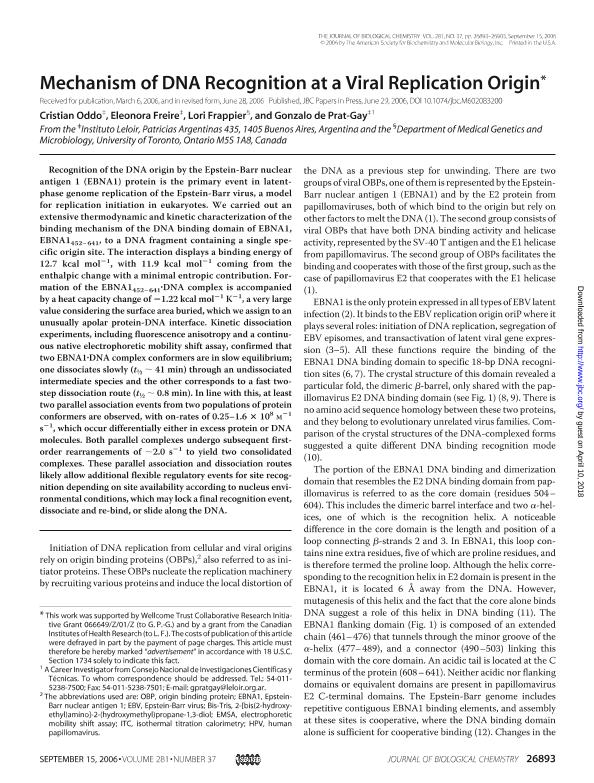Mostrar el registro sencillo del ítem
dc.contributor.author
Oddo, Cristian
dc.contributor.author
Freire Espeleta, Eleonora

dc.contributor.author
Frappier, Lori
dc.contributor.author
de Prat Gay, Gonzalo

dc.date.available
2018-04-10T19:04:53Z
dc.date.issued
2006-09
dc.identifier.citation
Oddo, Cristian; Freire Espeleta, Eleonora; Frappier, Lori; de Prat Gay, Gonzalo; Mechanism of DNA Recognition at a Viral Replication Origin; American Society for Biochemistry and Molecular Biology; Journal of Biological Chemistry (online); 281; 37; 9-2006; 26893-26903
dc.identifier.issn
0021-9258
dc.identifier.uri
http://hdl.handle.net/11336/41569
dc.description.abstract
Recognition of the DNA origin by the Epstein-Barr nuclear antigen 1 (EBNA1) protein is the primary event in latentphase genome replication of the Epstein-Barr virus, a model for replication initiation in eukaryotes. We carried out an extensive thermodynamic and kinetic characterization of the binding mechanism of the DNA binding domain of EBNA1, EBNA1452-641, to a DNA fragment containing a single specific origin site. The interaction displays a binding energy of 12.7 kcal mol-1, with 11.9 kcal mol-1 coming from the enthalpic change with a minimal entropic contribution. Formation of the EBNA1452-641.DNA complex is accompanied by a heat capacity change of -1.22 kcal mol-1 K-1, a very large value considering the surface area buried, which we assign to an unusually apolar protein-DNA interface. Kinetic dissociation experiments, including fluorescence anisotropy and a continuous native electrophoretic mobility shift assay, confirmed that two EBNA1.DNA complex conformers are in slow equilibrium; one dissociates slowly (t1/2 approximately 41 min) through an undissociated intermediate species and the other corresponds to a fast twostep dissociation route (t1/2 approximately 0.8 min). In line with this, at least two parallel association events from two populations of protein conformers are observed, with on-rates of 0.25-1.6x10(8) m-1 s-1, which occur differentially either in excess protein or DNA molecules. Both parallel complexes undergo subsequent firstorder rearrangements of approximately 2.0 s-1 to yield two consolidated complexes. These parallel association and dissociation routes likely allow additional flexible regulatory events for site recognition depending on site availability according to nucleus environmental conditions, which may lock a final recognition event, dissociate and re-bind, or slide along the DNA.
dc.format
application/pdf
dc.language.iso
eng
dc.publisher
American Society for Biochemistry and Molecular Biology

dc.rights
info:eu-repo/semantics/openAccess
dc.rights.uri
https://creativecommons.org/licenses/by-nc-sa/2.5/ar/
dc.subject
Viral Replication
dc.subject
Dna
dc.subject.classification
Otras Ciencias Químicas

dc.subject.classification
Ciencias Químicas

dc.subject.classification
CIENCIAS NATURALES Y EXACTAS

dc.title
Mechanism of DNA Recognition at a Viral Replication Origin
dc.type
info:eu-repo/semantics/article
dc.type
info:ar-repo/semantics/artículo
dc.type
info:eu-repo/semantics/publishedVersion
dc.date.updated
2018-04-05T19:23:46Z
dc.identifier.eissn
1083-351X
dc.journal.volume
281
dc.journal.number
37
dc.journal.pagination
26893-26903
dc.journal.pais
Estados Unidos

dc.journal.ciudad
Baltimore
dc.description.fil
Fil: Oddo, Cristian. Fundación Instituto Leloir; Argentina
dc.description.fil
Fil: Freire Espeleta, Eleonora. Fundación Instituto Leloir; Argentina
dc.description.fil
Fil: Frappier, Lori. University of Toronto; Canadá
dc.description.fil
Fil: de Prat Gay, Gonzalo. Consejo Nacional de Investigaciones Científicas y Técnicas. Oficina de Coordinación Administrativa Parque Centenario. Instituto de Investigaciones Bioquímicas de Buenos Aires. Fundación Instituto Leloir. Instituto de Investigaciones Bioquímicas de Buenos Aires; Argentina
dc.journal.title
Journal of Biological Chemistry (online)

dc.relation.alternativeid
info:eu-repo/semantics/altIdentifier/url/http://www.jbc.org/content/281/37/26893.long
dc.relation.alternativeid
info:eu-repo/semantics/altIdentifier/doi/http://dx.doi.org/10.1074/jbc.M602083200
Archivos asociados
